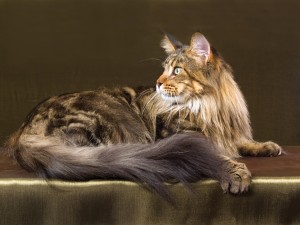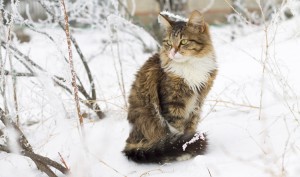A Wildcat in the House
July 7, 2017
A new study of ancient cat DNA reveals what many cat owners might long have suspected: your pet is barely domesticated at all. A team of scientists analyzed genetic material from more than 200 ancient cats obtained from Viking graves, Egyptian mummies, and Neolithic (later Stone Age) sites. The study revealed that despite having lived alongside people for thousands of years, cats really began to change only quite recently. The study was published in June in the journal Nature Ecology and Evolution.

A recent study showed that domestic cats like this Maine coon remain genetically quite similar to their wild ancestors. Maine coons, developed in New England in the 1800′s, are the largest domestic cat breed. Credit: © Linn Currie, Shutterstock
Cats have a long association with people. Archaeologists discovered a cat buried alongside a human in a 9,500-year-old grave in Cyprus. Yet cats have not not been fully domesticated the same way that dogs, cattle, pigs, sheep, or goats have been. Those familiar pet and farm animals differ from their wild ancestors in anatomy, behavior, and genetics. Modern house cats, however, remain very similar to their wild ancestors. Pet cats, of course, are much smaller than their wild cousins, but they remain near anatomic mirrors. Behaviorally, watch a panther or a lion in a nature program or in a zoo—then a house cat stalking a bird or simply watching you walk across the room—and you might notice quite similar patterns: sleeping a lot, playing, grooming, investigating, hunting, and even jumping into empty boxes. And genetically speaking, despite thousands of years of human interaction, pet cats did not begin to change until the past few centuries—and then, only a little. The domestication of cats has been neither complete nor easy. In fact, all house cats are descended from just one presumably friendlier-than-the-rest ancestor: the African wildcat.

The wildcat, from which modern house cats descended, still roams Africa, Asia, and Europe. Look familiar? Credit: © Vova Pomortzeff, Shutterstock
The genetic study focused on cat mitochondrial DNA (mtDNA), which is inherited unchanged solely from the mother. This fact makes mtDNA especially useful to trace the ancestry of different animal species. The genetic evidence showed that cat domestication probably began about 9,000 years ago in the Middle East, where farming started. Scholars think that wild cats (wildcats among them) were initially attracted to rodents that infested grain stores of early farmers. With plenty to eat, the cats stuck around the farms but never became fully domesticated. Cats then followed farming peoples as they migrated into Europe more than 6,000 years ago.

The genetic study showed that the familiar tabby markings of modern cats developed during the Middle Ages. Credit: © Shutterstock
The recent study found, however, that most modern pet cats are not directly descended from these first domesticated felines. More than 3,000 years ago, a second episode of cat domestication happened in ancient Egypt. These cats spread out of Egypt to Europe and beyond along Greek and Roman trade routes as far north as Scandinavia and into Asia. Most modern pet cats are descended from this second migration group.
The mtDNA analysis revealed that most domestic cats over the past 9,000 years were striped, like their wild ancestors (witness the tiger). The familiar tabby coats—symmetrically patterned with light stripes and blotches of a dark and light colors—of many house cats today were uncommon until the Middle Ages. It was around that time that people started paying more attention to their cats and started breeding them for different appearances and purposes. The genetic evidence even pinpointed the tabby mutation to western Turkey in the 1300’s. Most cats today carry this tabby gene, but there are now many different breeds from all over the world. The vast majority of cat breeds have been created since the early 1900’s.
Cat shows are popular today, but the very first cat show was much earlier than you might think. According to most accounts, the first show took place in 1598 at St. Giles Fair in Winchester, England. The first modern cat show was held at London’s Crystal Palace in 1871.


